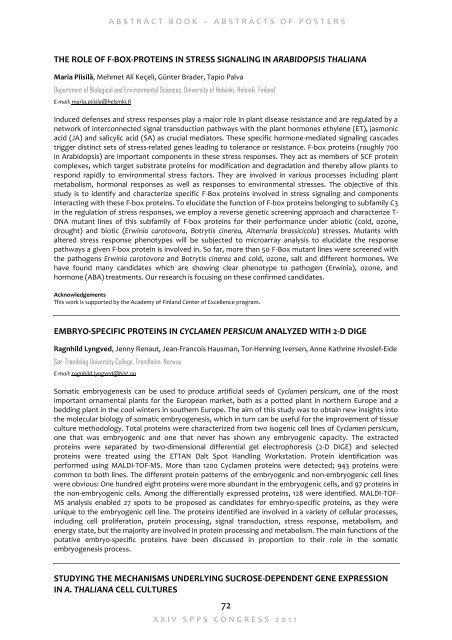1. Front Cover.cdr - CORE
1. Front Cover.cdr - CORE
1. Front Cover.cdr - CORE
Create successful ePaper yourself
Turn your PDF publications into a flip-book with our unique Google optimized e-Paper software.
A B S T R A C T B O O K – A B S T R A C T S O F P O S T E R S<br />
THE ROLE OF F-BOX-PROTEINS IN STRESS SIGNALING IN ARABIDOPSIS THALIANA<br />
Maria Piisilä, Mehmet Ali Keçeli, Günter Brader, Tapio Palva<br />
Department of Biological and Environmental Sciences, University of Helsinki, Helsinki, Finland<br />
E-mail: maria.piisila@helsinki.fi<br />
Induced defenses and stress responses play a major role in plant disease resistance and are regulated by a<br />
network of interconnected signal transduction pathways with the plant hormones ethylene (ET), jasmonic<br />
acid (JA) and salicylic acid (SA) as crucial mediators. These specific hormone-mediated signaling cascades<br />
trigger distinct sets of stress-related genes leading to tolerance or resistance. F-box proteins (roughly 700<br />
in Arabidopsis) are important components in these stress responses. They act as members of SCF protein<br />
complexes, which target substrate proteins for modification and degradation and thereby allow plants to<br />
respond rapidly to environmental stress factors. They are involved in various processes including plant<br />
metabolism, hormonal responses as well as responses to environmental stresses. The objective of this<br />
study is to identify and characterize specific F-Box proteins involved in stress signaling and components<br />
interacting with these F-box proteins. To elucidate the function of F-box proteins belonging to subfamily C3<br />
in the regulation of stress responses, we employ a reverse genetic screening approach and characterize T-<br />
DNA mutant lines of this subfamily of F-box proteins for their performance under abiotic (cold, ozone,<br />
drought) and biotic (Erwinia carotovora, Botrytis cinerea, Alternaria brassicicola) stresses. Mutants with<br />
altered stress response phenotypes will be subjected to microarray analysis to elucidate the response<br />
pathways a given F-box protein is involved in. So far, more than 50 F-Box mutant lines were screened with<br />
the pathogens Erwinia carotovora and Botrytis cinerea and cold, ozone, salt and different hormones. We<br />
have found many candidates which are showing clear phenotype to pathogen (Erwinia), ozone, and<br />
hormone (ABA) treatments. Our research is focusing on these confirmed candidates.<br />
Acknowledgements<br />
This work is supported by the Academy of Finland Center of Excellence program.<br />
EMBRYO-SPECIFIC PROTEINS IN CYCLAMEN PERSICUM ANALYZED WITH 2-D DIGE<br />
Ragnhild Lyngved, Jenny Renaut, Jean-Francois Hausman, Tor-Henning Iversen, Anne Kathrine Hvoslef-Eide<br />
Sør-Trøndelag University College, Trondheim, Norway<br />
E-mail: ragnhild.lyngved@hist.no<br />
Somatic embryogenesis can be used to produce artificial seeds of Cyclamen persicum, one of the most<br />
important ornamental plants for the European market, both as a potted plant in northern Europe and a<br />
bedding plant in the cool winters in southern Europe. The aim of this study was to obtain new insights into<br />
the molecular biology of somatic embryogenesis, which in turn can be useful for the improvement of tissue<br />
culture methodology. Total proteins were characterized from two isogenic cell lines of Cyclamen persicum,<br />
one that was embryogenic and one that never has shown any embryogenic capacity. The extracted<br />
proteins were separated by two-dimensional differential gel electrophoresis (2-D DIGE) and selected<br />
proteins were treated using the ETTAN Dalt Spot Handling Workstation. Protein identification was<br />
performed using MALDI-TOF-MS. More than 1200 Cyclamen proteins were detected; 943 proteins were<br />
common to both lines. The different protein patterns of the embryogenic and non-embryogenic cell lines<br />
were obvious: One hundred eight proteins were more abundant in the embryogenic cells, and 97 proteins in<br />
the non-embryogenic cells. Among the differentially expressed proteins, 128 were identified. MALDI-TOF-<br />
MS analysis enabled 27 spots to be proposed as candidates for embryo-specific proteins, as they were<br />
unique to the embryogenic cell line. The proteins identified are involved in a variety of cellular processes,<br />
including cell proliferation, protein processing, signal transduction, stress response, metabolism, and<br />
energy state, but the majority are involved in protein processing and metabolism. The main functions of the<br />
putative embryo-specific proteins have been discussed in proportion to their role in the somatic<br />
embryogenesis process.<br />
STUDYING THE MECHANISMS UNDERLYING SUCROSE-DEPENDENT GENE EXPRESSION<br />
IN A. THALIANA CELL CULTURES<br />
72<br />
X X I V S P P S C O N G R E S S 2 0 1 1


